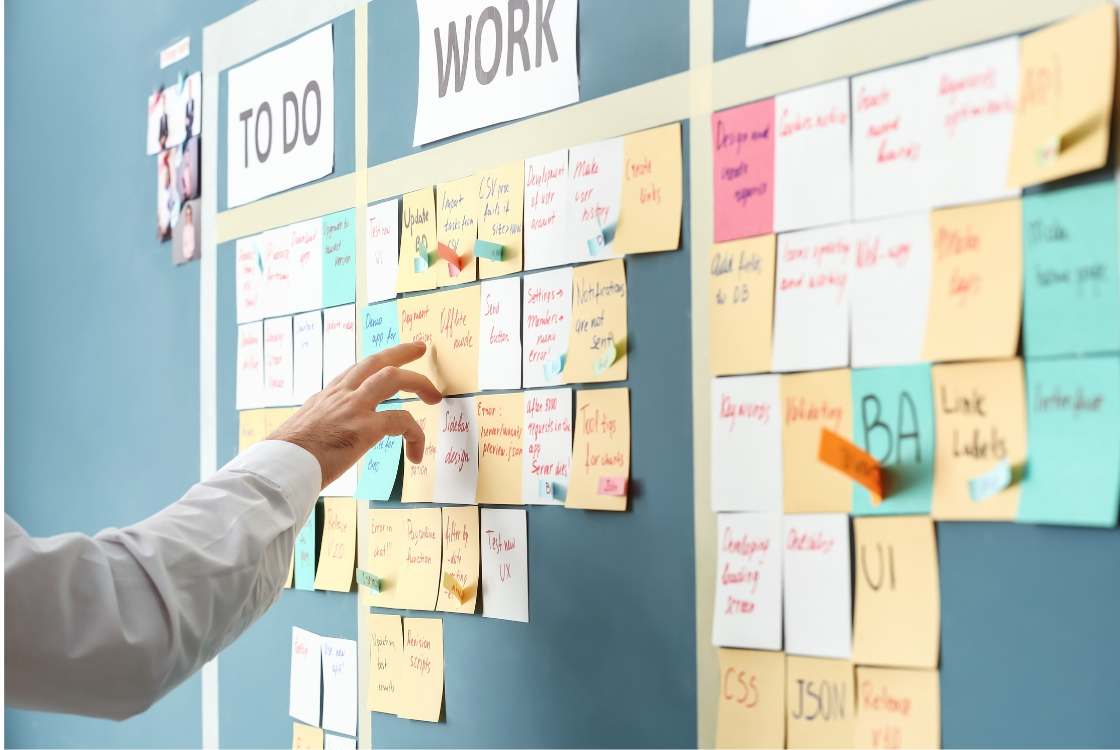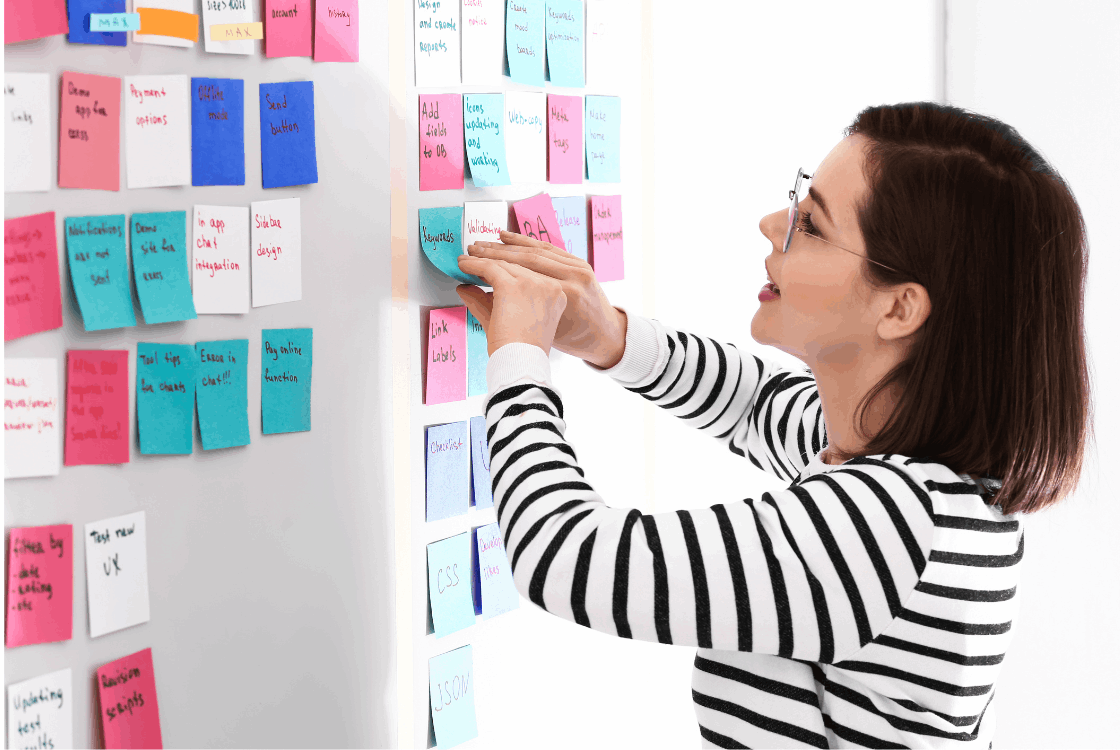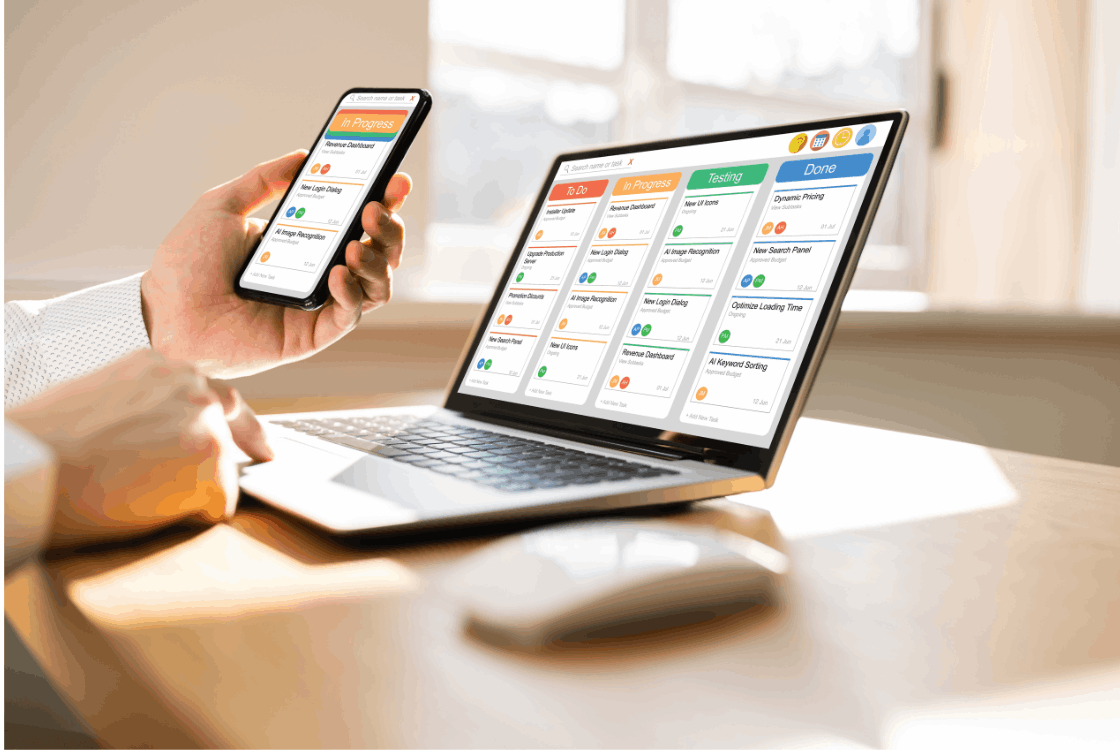The Scrum Board is a visual management tool used by Scrum teams to track the progress of tasks within a Sprint. It centralizes all necessary operational information needed for product development. Despite the lack of direct mention in the Scrum Guide, it plays a large role in managing work during a Sprint.
The board can be literally - placed on the wall or available online e.g., Jira, Trello, Asana, Azure DevOps. It's where the team monitors the progress of work on Product Backlog items and the Sprint Backlog.
A Scrum Board typically consists of several columns that represent different stages of the work process:
Each task is represented by a card or entry, which contains a brief description of the task, the person responsible for its completion, and possibly a due date. This organization allows for easy monitoring of progress and identification of potential obstacles. Additionally, it may include other complementary practices such as Acceptance Criteria or User Story description.
The board has columns representing different stages of work on tasks (e.g., "To Do," "In Progress," "Done"), but the team can customize it to their needs by adding new columns, such as "In Testing" or "Analysis." However, it is not advisable to reduce the number of columns below the three basic ones - it disrupts the purpose of using the board.
Other elements can also be added to the board: the Daily Scrum agenda, a Definition of Done checklist, a Burndown Chart, a table for tracking progress in fixing bugs or other obstacles, a table for tracking team members' leave requests, and so on. The greater the detail and the number of additional information, the more work managing them (updates, moving items from column to column, etc.). Therefore, it is always worth considering whether adding another column to the board will indeed streamline the workflow.
User Stories selected for implementation during a given Sprint are listed in the User Stories column, also known as the Sprint Backlog. They are then divided into various sub-tasks, which move from one column to another as progress is made in their completion.
Each User Story (along with its related group of sub-tasks) is separated on the board by horizontal "swimlanes," which prevent it from mixing with other Stories.

Using a Scrum board supports transparency - every team member has access to the current state of the product and can continuously observe the progress of work. It also significantly facilitates the conduct of Daily Scrum. The board also allows for better planning and allocation of resources - thanks to the visibility of all activities, it is possible to manage time more efficiently and avoid overloads of individual team members.
Additionally, the Scrum board promotes self-organization and self-management of the team. Employees have greater autonomy in choosing tasks to implement and independently decide on ways to solve problems. This, in turn, translates into greater engagement and motivation to work.
It's important to emphasize that the Scrum board is a flexible tool - it can be adapted to the specifics of a given product or team preferences.
Another key element is maintaining the board's currency. All changes in tasks should be reflected on the board in real-time. This facilitates communication within the team and allows for quick identification of problems and progress.
IRegular meetings at the board allow for the synchronization of actions and discussion of potential obstacles. These meetings should be short and focused on the board as the main point of discussion.
Using color coding can significantly improve the readability of the board. For example, different colors of cards can indicate different types of tasks or priorities. This allows for a quick assessment of the increment status without needing to delve into the details of each task.
It's also important to continuously adapt the board to the changing needs of the project and team. The Scrum board is not static - it should evolve along with the growing awareness of our product.

Functions of a physical Scrum board:
Functions of a virtual Scrum board:

A key feature of the Scrum Board is that it is reset after each Sprint. This means that at the beginning of each new sprint, all tasks can be reassessed and prioritized, and the board is updated to reflect the work plan for the upcoming sprint.
In contrast, the Kanban Board aims to continuously monitor the workflow. Like the Scrum Board, it is divided into columns representing different stages of the work process. However, unlike the Scrum Board, the Kanban Board is continuous - tasks are added to the board as they arise and moved through columns until they are completed, without the need to reset the board.
A key element of the Kanban Board is the principle of limiting work in progress (Work in Progress - WIP). Each column on the board has a specified WIP limit, which defines the maximum number of tasks that can be in a given column at any one time. This principle helps teams focus on completing started tasks instead of constantly adding new ones to the list.
Both the Scrum Board and the Kanban Board are powerful tools for visualizing work and help teams better manage their tasks. The choice between them depends on the project's specifics and the team's preferences. The Scrum Board may be a better choice for products that require regular iterations and frequent reviews of progress, while the Kanban Board may be more suitable for products or even projects that require continuous monitoring of the workflow.
Scrum is an agile framework that has gained wide recognition in various business sectors and industries due to its flexibility and effectiveness in project management. The Scrum Board, being one of the key tools of this framework, is used not only in software development but also in many other types of projects and industries.
For example, in the marketing industry, the Scrum board can be used to plan and track advertising campaigns. Each element of the campaign, such as content creation, graphic design, or market analysis, can be represented by a separate task on the board. Teams can easily adjust their actions to changing priorities and monitor progress in real-time.
In construction, the Scrum board helps coordinate complex projects, such as the construction of residential or commercial buildings. Different stages of construction - from design to implementation - can be divided into iterations, which allows for quick identification of problems and the introduction of necessary changes.
In education, the Scrum board is used to organize the work of project groups or plan an academic semester. Teachers and students can set goals together and track progress in learning, which promotes greater engagement and better organization of work.
The manufacturing sector also uses the Scrum board to optimize production processes. By using an iterative approach, it is possible to quickly respond to market changes and continuously improve products.
However, each industry requires an individual approach to implementing the Scrum board. It is important to adapt it to the specifics of a given project and the needs of the team. Regardless of the context, maintaining process transparency is key, as it facilitates communication among team members and allows for efficient work towards common goals.